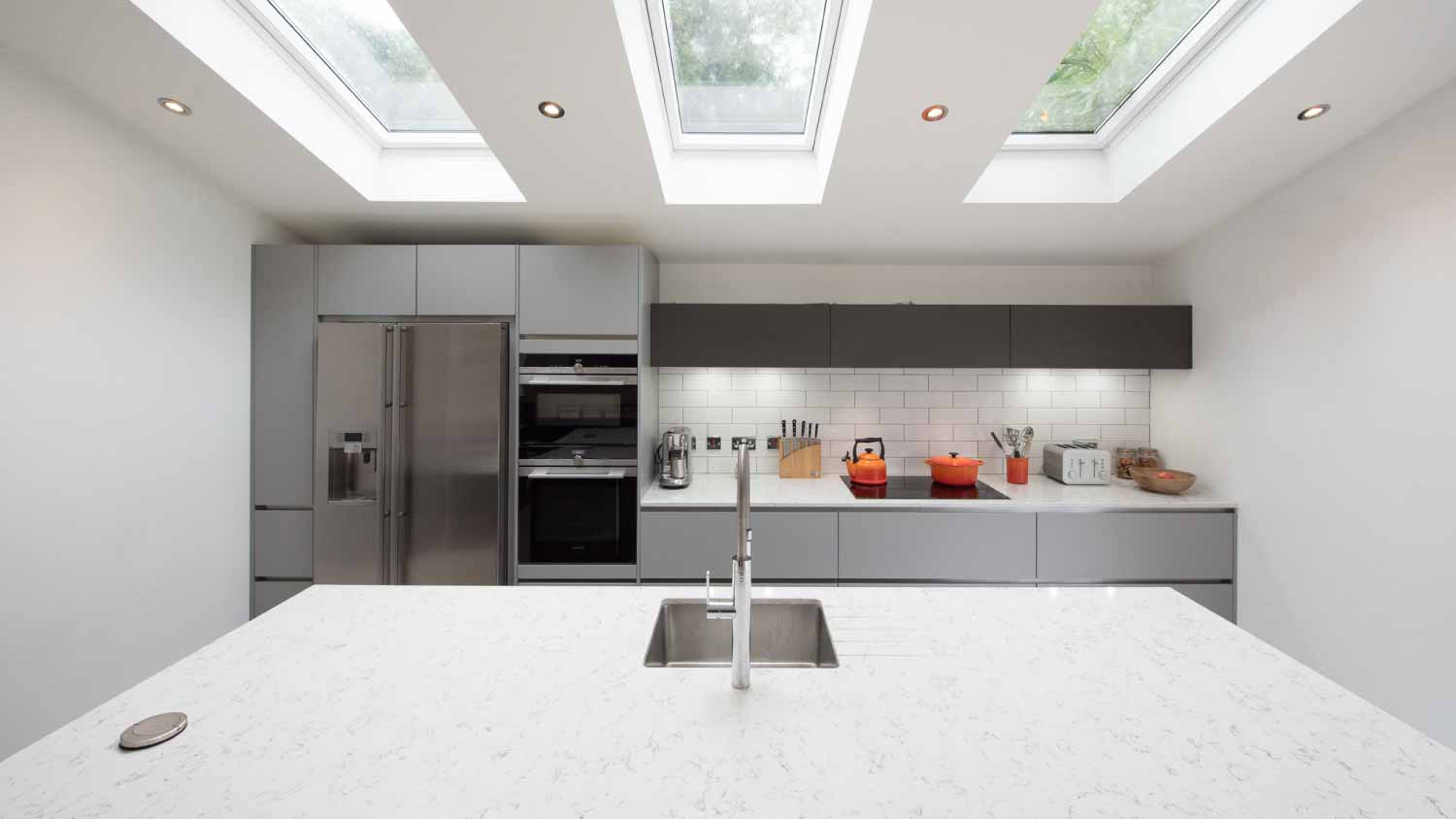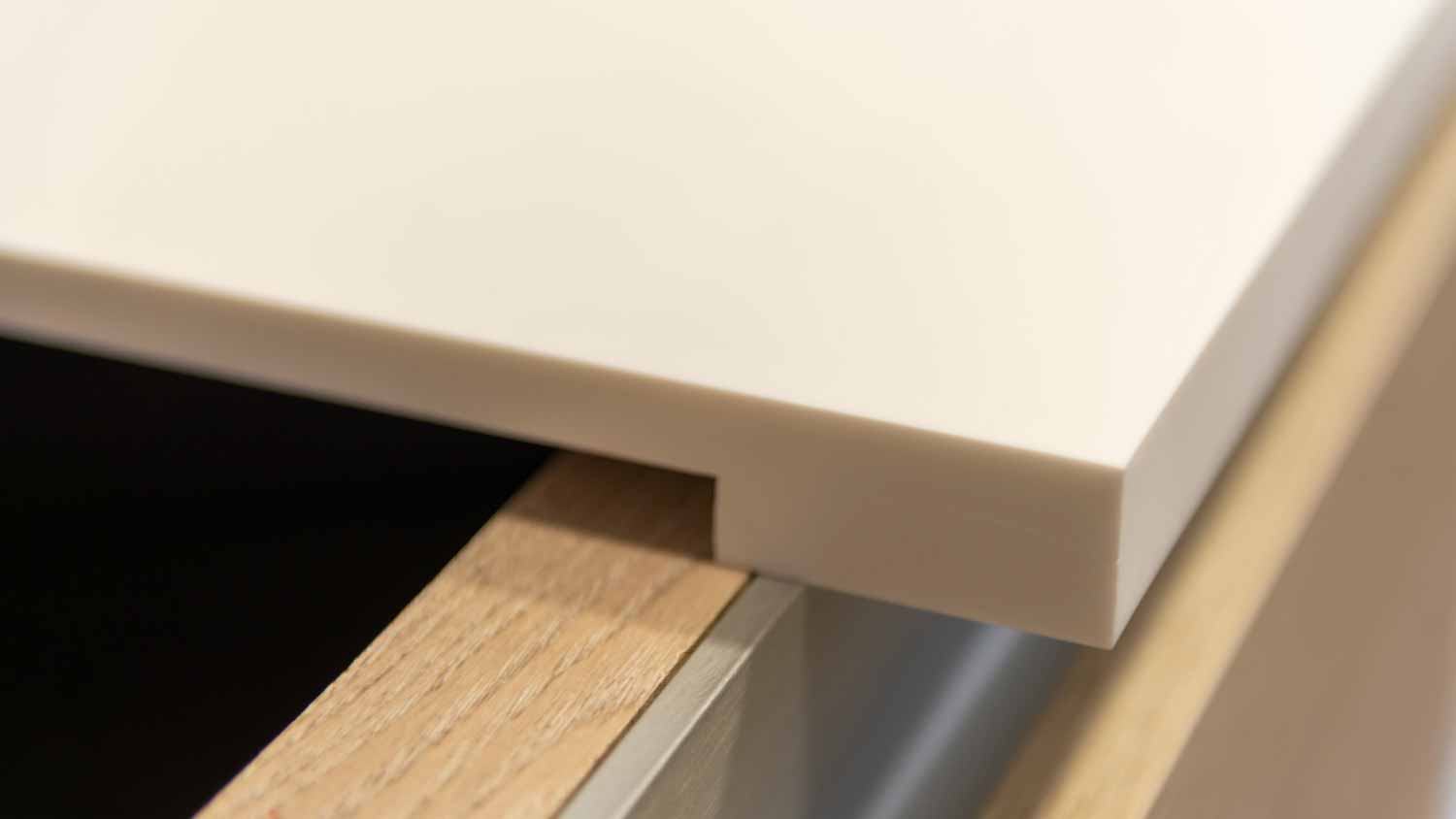
Butcher block countertops are a popular and durable choice for active kitchens. Learn how much it costs to install butcher block counters and what factors may affect pricing.
Tackle this task on your own with the right tools and techniques


Whether you are installing new countertops yourself or making cuts in order to install new fixtures or a new sink, knowing how to cut Corian® countertops can come in handy. Corian® countertops cost an average of almost $4,000, so cutting them correctly is essential to preserving this material and making sure it looks great for years to come.
Corian® is the DuPont brand of solid surface countertops. So, to answer the question, “What are Corian® countertops?”, we first have to answer the question, “What are solid surface countertops?”
Solid surface material is a factory-made product that has a consistent makeup throughout. Whereas laminate is manufactured by pressing many layers together, and granite is produced by cutting large slabs of natural stone and polishing them, solid surface products take natural minerals and stones and mix them with resins, acrylic, and pigments. These are then molded into the desired shape. This creates an incredibly durable material that can be formed into different types of solid surface countertops.

If you are installing a solid surface countertop on your own, it is pretty obvious why you would need to know how to cut Corian® countertops. And if you had it professionally installed, chances are that your local Corian® countertop installer did all the cutting for you. So, why would you need to cut Corian® countertops now? There are a few possible reasons:
You installed an island and want the new countertop to match the existing countertop.
You are installing a new fixture or sink that does not fit the existing holes.
You are removing cabinets and need to cut away the countertop that sat on them.
Tools:
Measuring tape
Pencil or grease marker
Straightedge or speed square
Circular saw
60-tool triple chip grind blade made from tungsten carbide
Saw horses or sturdy table
Safety goggles
Dust mask or respirator
Supplies:
Medium-grit sandpaper
Assess the surface where you will be installing the Corian® countertop and take the necessary measurements to determine the size you will need. Make sure to measure as accurately as possible because you want to avoid having to make more cuts or wasting material due to errors. Write down your measurements, so you do not forget.
After setting up the saw horses or other sturdy cutting surface, place the slab upside down. If you want it to be even more stable, you can use clamps to fasten it to the work surface.
Mark the measurements for your cuts on the underside of the slab, making sure they are oriented correctly if you want the slab to face a certain way. You can use your straightedge to ensure the guiding lines are straight and measured accurately. To get as accurate a cut as possible, clamp a straightedge to the countertop so you can run the baseplate of the saw along it while cutting.
Before cutting Corian® countertops, put on your goggles and dust mask or respirator. Using a circular saw fitted with the triple chip grind blade, begin to cut along the lines you marked in the previous step. Make sure that, when you start the saw, it is a few inches away from the Corian® and is not touching it. Once the saw gets up to full speed, move it toward the Corian® and begin cutting.
Cut through the Corian® using moderate pressure on the saw, but allowing the blade to do the majority of the work. If you feel like you are having to push too hard or if the blade jumps or starts to smoke, stop cutting. Wait for the blade to stop moving and remove the saw from the cut. Reposition the saw and begin again. If the blade is hot, wait for it to cool down before repositioning it.
This step is especially important if there will be large offcut pieces—scraps that come off the main slab. If the offcut piece falls before the cut is complete, it can rip off the corner of the slab, potentially ruining the whole thing. Having another table set in place to catch the offcut, or enlisting the help of a friend to hold onto it, can help avoid this situation.
To ensure the edges of the Corian® fit together as tightly as possible, you should sand the cut edges with medium-grit sandpaper; 100- to 150-grit should do the trick. Run your fingers along the edge and sand any areas that are bumpy or rough. If, after sanding a few times, there are still rough areas, you may want to move up to a 320- or higher grit sandpaper to smooth out the final imperfections.

In some situations, you may need to cut Corian® that is already installed as your countertop—for instance, if you are installing a new sink or new fixtures. If this is the case, here are a few tips for cutting existing Corian®.
Measure the sink or fixture.
Create a template that matches the size of the sink or fixture and cut it out.
Place the template in the correct spot on the Corian® countertop and tape it to the countertop with masking tape.
Trace the outline of the template onto the Corian®.
Using an electric drill, drill a hole on each side of the outline about a half-inch inside the outline.
Using one of the holes as a starting point, cut around the outline with a fine-tooth down-cutting jigsaw blade, cutting just fast enough to allow the blade to do most of the work.
After the hole is cut, sand the edges using an orbital sander, starting with a coarser grit sandpaper and switching to progressively finer grit sandpaper until the edges are smooth.
To cut Corian® countertops well requires the right tools and a certain skill level. If you lack those, you might want to consider hiring a pro. If you are comfortable using a circular saw and confident in your measuring abilities, a skilled homeowner could tackle this project on their own to save money on labor and to achieve their kitchen countertop ideas on a budget. Luckily, if you decide to install a Corian® countertop yourself, they often come cut to size and will not need to be cut on site.
From average costs to expert advice, get all the answers you need to get your job done.

Butcher block countertops are a popular and durable choice for active kitchens. Learn how much it costs to install butcher block counters and what factors may affect pricing.

Granite counters are durable and stylish, but if you’re wondering how much granite countertops cost, it’s time to dig into the details.

Discover the cost of installing laminate countertops, including how their size, material, and finish impact your total price.

We share all the ins and outs for homeowners wondering how to epoxy countertops. Our tips will help you avoid all of the common project pitfalls.

If your countertops are getting old, dull, or showing signs of wear, it may be time to do something. But to refinish vs. replace countertops is the question.

Butcher block counters are a cost-effective and beautiful option. Learn the butcher block countertop pros and cons to see if they’re right for your kitchen remodel.